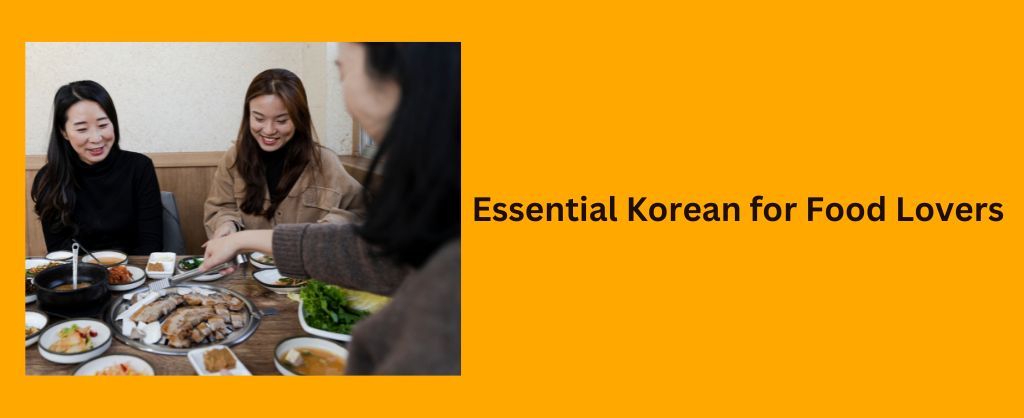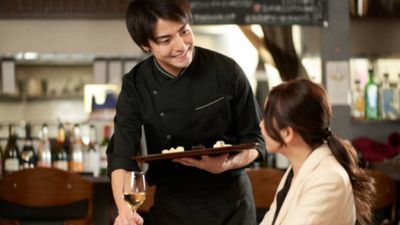Korean Dining Vocabulary for Beginners: Essential Phrases & Tips

Hey there Korean food fans! Ready to level up your Korean dining skills? I’m here to drop some sweet Korean phrases and vocab so you can navigate restaurants and street stalls like a boss.
We’ll cover all the lingo you need to know, from greetings to ordering, plus tips to not accidentally offend anyone with your chopstick skills.
Watch the videos to improve your pronunciation and for more phrases. Get ready to have your mind blown by how much your Korean food adventures will improve after this crash course!
Greeting and Chatting with Staff
Rolling up to a Korean restaurant can be intimidating if you don’t know the basics. So let’s kick things off with some key phrases to break the ice with the staff!
Say Hello and Goodbye
Annyeonghaseyo (안녕하세요) – Hello
Annyeonghi gaseyo (안녕히 가세요) – Goodbye
Bust these out when entering and exiting any establishment for smooth interactions.
Master the Korean Language with these 14 Top YouTube Channels
Give Thanks
Gamsahabnida (감사합니다) – Thank you
Cheonman-eyo (천만에요) – You’re welcome
Show your gratitude with these handy phrases after any help from the staff.
Excuse Yourself
Joesonghabnida (죄송합니다) – Sorry/Excuse me
Jeogiyo (저기요) – Excuse me (to get attention)
Whoops, need to squeeze by to get to your table? Whip these out to avoid rudeness.
Confirming and Clarifying
Ye (예) – Yes
Aniyo (아니요) – No
Nail down preferences and order clarifications with these must-know phrases.
Andwae (안돼) – No way
Jamkkanman (잠깐만) – Just a moment
If something just won’t fly, you gotta let them know with “Andwae!” Also handy is “Jamkkanman” if you need a sec to decide.
Here are some more useful phrases for interacting with restaurant staff:
- 종업원 (jong-eob-won) – server, staff member
- 계산서 (gye-san-seo) – bill, check
- 신용카드 (shi-nyong-ka-du) – credit card
- 팁 (thip) – tip
Some examples:
- 계산서를 부탁드립니다. (gye-san-seo-reul bu-tak-deu-rim-ni-da) – Can we have the check please?
- 카드로 계산할게요. (ka-deu-ro gye-san-hal-ge-yo) – I’ll pay by card.
- 팁은 얼마예요? (thib-eun eol-ma-ye-yo?) – How much should I tip?
Phew, now you can handle the basics of interacting with restaurant staff in Korean!
Time to Order – Food Vocab 101
Now for the delicious part – ordering! Here are some key Korean food vocabulary words to help you achieve food bliss:
Eumsik (음식) or Bap (밥) – Meal/Food
Guk (국) – Soup
Kkochi (꽂치) – Side dish
Masissneun bokkeumbap (맛있는 볶은밥) – Delicious fried rice
Mul-naengmyeon (물냉면) – Cold buckwheat noodles
Bibimbap (비빔밥) – Mixed rice with meat and vegetables
Bulgogi (불고기) – Marinated grilled beef
Samgyeopsal (삼겹살) – Grilled pork belly
Galbi (갈비) – Grilled short ribs
Haemul pajeon (해물파전) – Seafood pancake
Kimchi bokkeumbap (김치 볶음밥) – Kimchi fried rice
Tteokbokki (떡볶이) – Spicy rice cakes
Ramyeon (라면) – Instant noodles
Kongguksu (콩국수) – Soybean noodle soup
Bibim-naengmyeon (비빔냉면) – Spicy cold noodles
Soondae (순대) – Korean blood sausage
Bindaetteok (빈대떡) – Mung bean pancakes
Gyeran-ppang (계란빵) – Egg bread
Hwachae (화채) – Fruit punch
Maeuntang (매운탕) – Spicy fish stew
Saengseon hoe (생선회) – Raw fish
Eomuk (어묵) – Fish cake
Dak-gangjeong (닭강정) – Fried chicken
Now you’ve got a super handy Korean food vocabulary list to get ordering like a pro. Time to master those pronunciations!
At the Table
Here are some phrases that will be handy when dining at a restaurant:
- 자리 (ja-ri) – seat
- 젓가락 (jeot-ga-rak) – chopsticks
- 포크 (po-keu) – fork
- 숟가락 (sot-ga-rak) – spoon
- 유리 (yoo-ri) – glass
- 물 (mul) – water
Some examples:
- 물 좀 주시겠어요? (mul jom ju-si-get-seo-yo?) – Could I get some water, please?
- 젓가락 사용법을 잘 모르겠어요. (jeot-ga-rak sa-yong-beob-eul jal mo-reu-get-seo-yo.) – I’m not very good with using chopsticks.
- 숟가락이 하나 필요해요. (sot-ga-ra-gi ha-na pi-lyo-hae-yo.) – I need an extra spoon.
Describing Your Food Preferences
Talk about what kinds of foods you like and dislike using words such as:
- 좋아하다 (jo-a-ha-da) – to like
- 싫어하다 (si-reo-ha-da) – to dislike
- 알러지가 있다 (al-leo-ji-ga it-da) – to be allergic to
- 먹다 (meok-da) – to eat
- 피하다 (pi-ha-da) – to avoid
Some examples:
- 쌀밥을 먹는 것을 좋아해요. (ssal-bap-eul meok-neun geo-seul jo-a-hae-yo.) – I like eating rice.
- 생선 요리는 싫어해요. (saeng-seon yo-ri-neun si-reo-hae-yo.) – I dislike fish dishes.
- 조개 알러지가 있어서 조개류는 먹지 않아요. (jo-gae al-leo-ji-ga is-seo jo-gae-lyu-neun meok-ji a-na-yo.) – I’m allergic to shellfish so I avoid shellfish.
- 고기는 별로 먹지 않습니다. (go-gi-neun byeol-lo meok-ji an-seub-ni-da.) – I don’t eat much meat.
Some More Useful Restaurant Words
Here are some other handy restaurant terms in Korean:
- 만원 (man-won) – 10,000 won (Korean currency)
- 예약 (ye-yak) – reservation
- 테이블 (te-i-beul) – table
- 메뉴 (me-nyu) – menu
- 영업시간 (yeong-eob si-gan) – business hours
- 화장실 (hwa-jang-sil) – restroom
Some examples:
- _____시에 _명을 위한 테이블을 예약했어요. ( si-e ____ myeong-eul wi-han te-i-beul-eul ye-yak-haess-eo-yo) – I made a reservation for ____ people at __ o’clock.
- 메뉴를 한번 볼 수 있을까요? (me-nyu-reul han-beon bol su is-seul-kka-yo?) – May I see a menu?
- 화장실은 어디에 있나요? (hwa-jang-sil-eun eo-di-e in-na-yo?) – Where is the restroom?
Talking About Taste
Describe how the food tastes using words like:
- 맛있다 (mas-it-da) – delicious
- 너무 짜다 (neo-mu jja-da) – too salty
- 너무 맵다 (neo-mu maep-da) – too spicy
Some examples:
- 이 음식은 맛있어요. (i eum-si-geun mas-it-seo-yo) – This food is delicious.
- 좀 덜 짜게 해주세요. (jom deol jja-ge hae-joo-se-yo) – Please make it less salty.
- 매운 음식을 잘 못 먹어요. (mae-un eum-si-geul jal mot meo-geo-yo) – I can’t handle spicy foods well.
Nailed it! With these phrases they’ll think you’re a local.
Minding Your Manners: Dining Etiquette
Alright, we’re cruising now. Just a few etiquette tips so you don’t accidentally offend anyone with your table manners:
- Greet staff when entering and leaving.
- Wait to start eating until elders begin.
- Pour drinks for others, don’t help yourself.
- Don’t stick chopsticks straight up in rice.
- Don’t blow your nose at the table.
- Leaving a little food behind is polite.
- Skip the tipping.
Follow these tips and you’ll impress everyone with your manners!
Wrapping Up
Whew, we covered a ton of ground here – you’re basically a Korean dining expert now! With all these Korean phrases and tips in your back pocket, you’ll have the confidence to dine at any restaurant or street stall like a local.
Time to finally try that Seoul food tour you’ve been dreaming about! Let me know if you have any other Korean dining questions. Now go out there, get your Korean foodie on and have the best dining experience ever!












